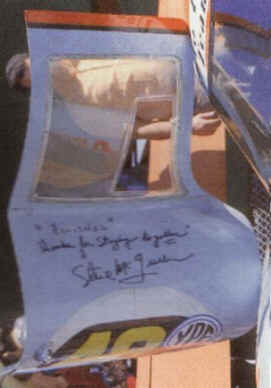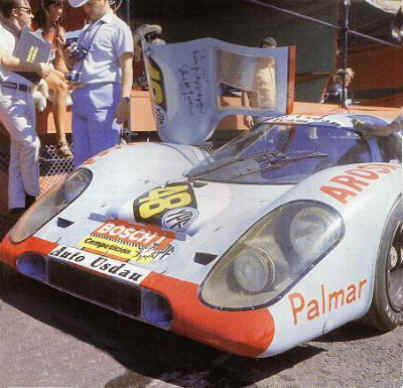1971
Season (Part 1)
FIRST
RACE: 1000 KM. OF BUENOS AIRES
SPORTS
SYNTHESIS
Commentaries
and images extracted from the Parabrisas
Corsa Magazine, Nº247 of January 1971
|
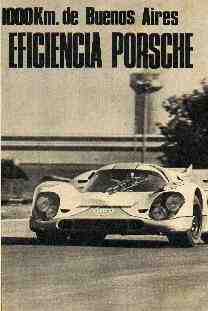
|
Wednesday
06 of January:
After
the Wednesday practice previous to the race, the balance for John
Wyer´s Team Gulf-Porsche was quite discouraging. The
off-track of Jackie Oliver with damages to the nose of its 917,
erased the smile off David Yorke´s face; whatsoever good thing
that Derek Bell had done in the track, looking for tricks of the
trade on driving the 917, and traveling at speeds very below the
normal thing in the straight lines. Anyway, the maximum speed
superiority of the German cars could be seen, comparing it to the Alfa
Romeo, of only 3 liters, but not thus in smaller classes, where the
dominators of the category showed defects that were reflected in the
clocks. A nose that was almost impossible to turn-in, and a tail that
flamed more than necessary, were the details that Bell let know
to the people of the team.
|
The
Ferrari 512M of Parkes-Nonnier of the Scudería Filippinetti
lead by Mike Parkes displayed an amazing power and a frightful sound that
expressed his almost 600 BHP. Equally, the power-to-weight ratio of the 512 was
less convenient than the one of the Porsche (slightly less powerful, but
much more lighter).
|

Photo sent by Oscar Jarillo
|
Jackie
Oliver declared after its accident: "It
was my mistake, is not possible to blame to anybody else, not even the car. I
entered the curve and stayed there. I came in very hard and car tended to go
outwards.... finally while it tried to fight it, I reached the section where
curve is closes in, and the spinning began. I ended up backwards, and touched
the guardrail with the right side of the nose. Luckily nothing vital was broken,
except for the plastic. But I insist, it was my mistake."
The new nose would arrive Friday at the last minute.
|
|
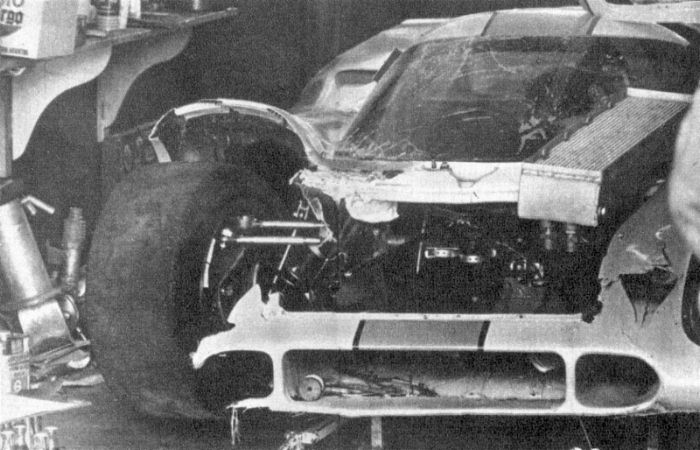
We can see that not only the plastics were broken. The windshield indicates it
Photo sent by Oscar Jarillo
|
Thursday,
07 of January
From
the first practices of the day, Vic Elford debuting with the 917
of the International Martini Team ended the farce and it demonstrated
that it was possible to turn very fast with the 917. Powersliding through
the whole session, braking late, and accelerating in the right spot, he managed
to clock 23 seconds; an absolute record for the section.
|

|
Vic
Elford, cigar in mouth, ready to put the overall on; and to
clock, in Thursday, the best time. |
First
hour of afternoon, and Elford went out again, while his co-driver, Gerard
Larrousse still wore his shining black velvet trousers and yellow chemise.
Soon after leaving, the Porsche stalled in the chicane previous to the
“Drawer” curve, because the gasoline pump had inhaled water, since probably
during the boat trip, humidity was strained by some of the conduits.
The
team surpassed the problem disarming the fuel pump and pipe. Fifteen minutes
before they finished the tests of the day, the 917 to the control of Vic
Elford appeared again and a sensational spectacle began, where it finally
did the best unofficial time of the afternoon with 1m55s7/10.
In
the practice, the ex- mailman straightened the pavement.
Friday,
08 of January
First
day of official tests. When the day ended, both best times were for John Wyer´s
new duo, and the Martini Racing; Siffert-Bell and Elford-Larrousse,
respectively.
Saturday,
09 of January
Classification
day.
Siffert-Bell
obtained the third best time, but they bust a valve, attributed to overreving
the engine, courtesy of Siffert; which forced a change of motor.
|

|
The dusk
found in first place Rodriguez-Oliver with 1m52s70 and second Giunti-Merzario
at just 4 hundredth of a second behind, with the latest Ferrari 312P
(unique prototype).
|
In
certain way, the pole time disappointed, since the performance of the 917
in January of 1970 was remembered done by David Piper and Brian Redman,
when in classification of the 1000 km of Buenos Aires (non
championship) they did 1m52s and something. Since now the 917 had 5000 cm³,
620 HP and a 5 speed gearbox, it was expected that the minute and 52s was
comfortably beaten.
Sunday,
10 of January
The
race.
After
a brief lap by the small perimetral of the Buenos Aires
track, the pace car retired, and the chilling acceleration of the Ferrari
312P put Ignazio Giunti to the lead of the pack, with the 917´s
of Rodriguez, Siffert and Elford following, and trying to
reach to the small Italian car.

Photo courtesy by
Alvaro Camaño
|
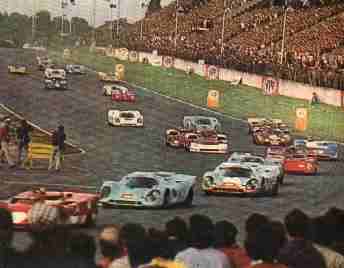
|
When
leaving the opposite straight, the Ferrari flew towards the Ascari
curve.
Cover photo
of the"El Gráfico " magazine Nº2675; January ' 71 |
The
speed was impressive and between all, Rodriguez went inside, and overtook
Giunti, just before the unavoidable braking point. With the celestial Porsche
leading, the squad entered Ascari, followed by Giunti, harassed by
Siffert and completing the leading pack, Vic Elford although with
some lost meters.
Everything
followed this way, until in the sixth lap Siffert, pushing with all he
got in the opposite straight, managed to rob the second position to Giunti
and in the eighth lap, Elford was able as well to pass the small Ferrari.
A couple of laps more, Siffert missed the entrance to the compound pulling back
to the thirteenth position, and leaving Vic the second place. Siffert said "
I went behind a Ferrari, when suddenly an oil cloud surrounded me. I activated
the windshield wiper and I couldn’t see absolutely anything "
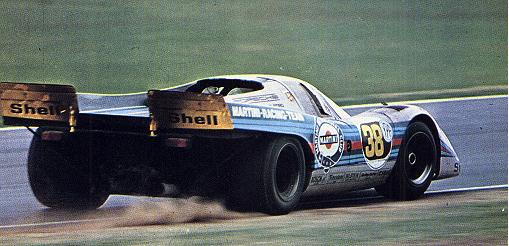 Vic Elford
Vic Elford
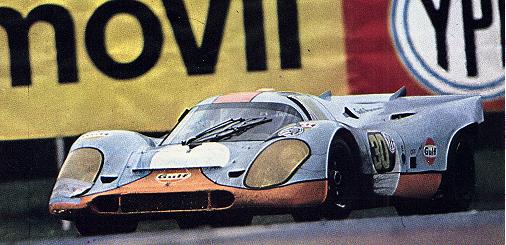 Joseph Siffert
Joseph Siffert
In
the 16th lap, Elford it is able to surpass Rodriguez and
demonstrating that he had the quickest 917, and than his driving was the best of
the day, moved away from the lead, clocking amazing times and establishing the
lap record at 1m51s17 with an average speed of 198.238km/h. In lap 29 the
silver-plated sharpshooting car made a noise that sounded just like an ignited
blowpipe, and stopped abruptly in the entrance to the " Cajon " losing
every chance.
In
lap 38, when the incredible accident caused by Jean Pierre Beltoise –accident
that took the life of Ignazio Giunti-, he was circumstantially first in the
race, since the Porsches had stopped to resupply, and as the race did not stop,
for a long while only the lap chart men were aware of what was happening in the
race standings. The cars entered and left boxes, changed pilots, repaired,
resupplied, and even Elford brought the car back to boxes, after being
unlawfully restarted by his mechanics in the sweepers. When Larrousse was
driving, he would be stopped with black flag, disqualified by Elford´s
infraction.
In
the middle of the confusion and with debris of the accident still on the track,
Rodriguez -the leader- undergoes a tire puncture and must leave the first place
into the hands of his teammate Siffert, who had carried out a spectacular
overcome, after its delay in the beginning of the race.
Of
there in more, the race did not have more interesting alternatives, standing out
only the quick regularity of the leaders; Siffert did the habitual, but Derek
Bell proved to be an excellent teammate in his first race with the 917
demonstrating sobriety and class, in contrast to Jackie Oliver that in little
contributed to the second final position with Rodriguez.
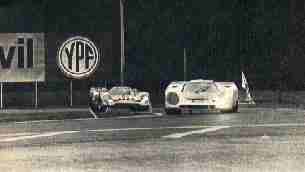 |
Lights ignited
and power-slide, courtesy of Rodriguez in the celestial blue car. The
fight for the lead is about to culminate. |
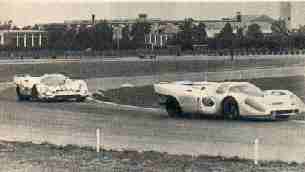 |
The Ombú
curve. Rodriguez resists; note left front wheel in the air. The 917 of
Elford is already straightening and sliding. |
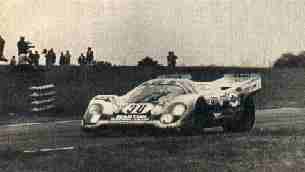 |
Braking at the
entrance to the compound, Elford is already leading. Rodriguez is ten
meters back, totally surpassed. |
Really,
the first and second position of Porsche was an example of the impeccable
invoice of each success of this marque and its pilots -under the Wyer
administration- and the tactics of David Yorke.
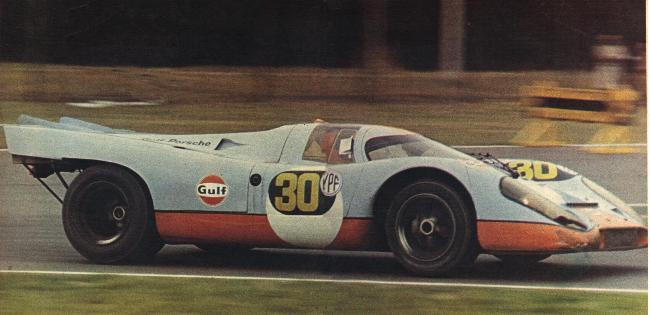
Los ganadores Siffert - Bell
|

|
The third and fourth position of
Alfa Romeo with Stommelen-Galli and De Adamich-Pescarolo was the prize for its
untiring certainty with the 3-litre prototypes. |
THE ARGENTINIAN
Carlos Reutemann
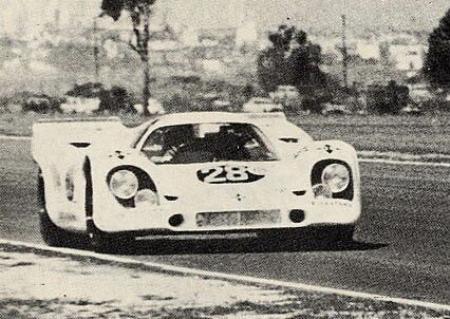
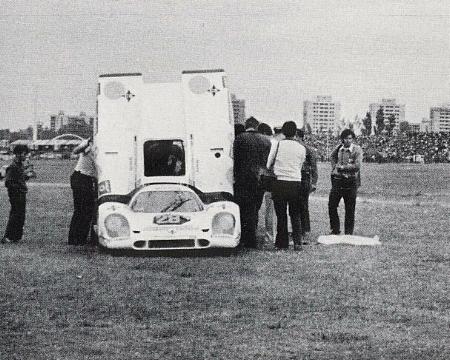
|
Carlos Reutemann,
who in 1981was world sub champion in the
F1, was by that time giving his first steps in the international
categories (he used to run a Brabham in the European F2 ).
In the 1000 km. Buenos Aires in 19'71, he shared
a 917 with Emerson
Fittipaldi.
In the They classified in the ninth position four seconds
later than the pole, and quit the race during the 43rd round. |
A
continuación puede apreciarse cuatro fotos del 917 #28
gentilmente enviadas por Oscar Jarillo
Angel Rubén Monguzzi
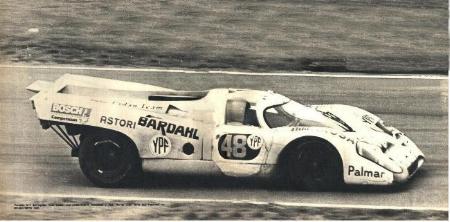 |
El
917 del Auto Usdau con el que corrieron Joest y Monguzzi.
En "Misceláneas" se pueden leer las impresiones de manejo de Angel
Monguzzi. |
|
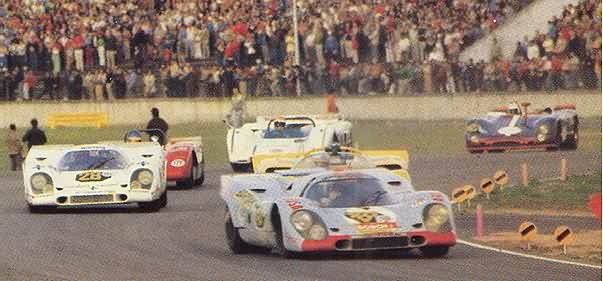
|
|
El 917 Nº 48 ex John Wyer de Joest/Monguzzi y
el Nº28 de Reutemann/Fittipaldi |
Pablo Brea
|

|
|
Porsche 917K # 34 (chassis 025)
Team Zitro Racing. The drivers: Dominique Martin and the argentinian Pablo
Brea. they finished in the tenth place. (Photo extracted from " Automobiles Historique"
french magazine -
Courtesy by Philippe
Moriniere) |
|
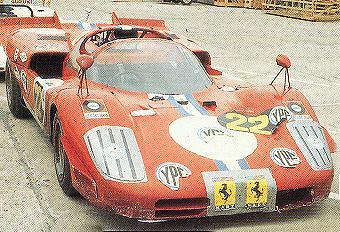
|
Esta es la Ferrari 512S Spyder del
Equipo North American Racing Team que el piloto argentino Néstor Jesús
García Veiga compartió con el norteamericano Sam Posey.
Finalizaron en el 8º lugar a 17
vueltas de los ganadores |
(publicadas en la revista "El Gráfico" Nº2675 del 12 de
Enero de 1971)
-
Todo el mundo coincidió en
que el box mejor organizado era el de Alfa Romeo por los trabajos
realizados durante los entrenamientos y las clasificaciones. Además, en el
transcurso de la carrera sorprendieron cuando a las 12:40 paró Stommelen
para dejarle su lugar a Nanni Galli. En ese cambio y cargando tres
bidones de nafta, emplearon 1m 1s.
-
El auto que más paró en
boxes fué el Lola de Rouveyrant-Ruesch. desde el comienzo
tuvo problemas de alimentación. Se le computaron mas de 15 detenciones.
-
El box mas lento en toda la
carrera fue el del Lola, tripulado por D.Wier y el argentino Jorge
Omar del Río. Cuando Jorge subió al auto, el cambio se hizo en
2m 23s. Luego en otro cambio de piloto, se le computó 2 minutos exactos.
-
En el box de Alfa Romeo
la organización llegó a su punto máximo. Hay un hombre que se encarga
únicamente de revisar el aceite cuando paran los autos. Cuando estaban
reabasteciendo la máquina de De Adamich-Pescarolo, y al verlo
trabajar muy lentamente, se le preguntó el porqué. El señor contestó de
una manera muy simple: "Yo solo me encargo de cuidar el aceite.
esto es un equipo".
-
El primer auto que paró en
boxes fue el Porsche de Gijs Van Lennep-Helmut Marko y en
seguida lo guardaron porque estaba roto el motor.
|

|
|
El 917K Nº 36 del
Equipo Martini conducido por Helmut Marko y Gijs Van Lennep. Abandonaron
en la segunda vuelta por problemas en el motor. (Foto de
la revista francesa Automobiles Historique - Cortesía de Philippe
Moriniere) |
-
El último coche en salir
de boxes fue la Ferrari 512 de Possey-Di Palma-García Veiga
para que este último le dejase el lugar a Di Palma.
-
Muchos se asombraron cuando
los dos Alfa pararon en boxes para cargar nafta y cambiar de pilotos.
Pero mas aún cuando vieron salir las dos máquinas juntas. Mas tarde, Roberto
Bussinello explicaba: "Hay carreras en las que los
integrantes juegan apuestas para ver quien hace los trabajos mas
rápidamente".
-
Como es de costumbre, en el
box de Juncadella-Pairetti estuvieron colaborando los eternos amigos
de Pairetti: Fernández Pelayo, Daporta, y "el
laucha" Ríos.
-
El Club Y.P.F. (Yacimientos
Petrolíferos Fiscales) instaló, como el año anterior, una serie de
surtidores para el reabastecimiento de las máquinas. Pero ninguna de las
máquinas paró allí para cargar nafta, ya que lo hacían cada vez que se
detenían en boxes para un cambio de piloto ó alguna reparación.
-
El auto que menos paró en
boxes fue el de Andrea De Adamich-Pescarolo. Solamente una vez debió
hacerlo Pescarolo para arreglar la parte derecha de la trompa del Alfa
que estaba golpeada.
-
Sam Possey largó
con la Ferrari y cuando se bajó del auto no quiso subir más. Luego
se supo que el piloto prefirió que lo pilotearan Di Palma y García
Veiga, porque dijo que la máquina estaba puesta a punto para los
pilotos argentinos, que el se sentía muy incómodo...
-
Carlos Ruesch se
preguntaba: ¿Para que tantos camiones de bomberos si no sirven para nada?.
la única solución posible para accidentes como el que le ocurrió a Giunti
es utilizar el método de la Asociación Argentina de Sport Prototipo:
poner una persona cada 200 metros con extintor y traje antiflama. Lo que
además le asombraba es que se trató de apagar la nafta ardiendo con agua.
-
Pedro Rodríguez fue
el piloto mas aplaudido de los extranjeros que subieron al podio. Algunos
decían que porque era el único que hablaba castellano, y otros, porque era
el mas sociable de todos.
-
Cuando los Alfa Romeo
entraron en boxes por el accidente ocurrido a Giunti, el ingeniero Chitti
fue corriendo a reclamarle al Comisario de la prueba que parara la carrera
porque era una locura continuar. Seguramente el director del equipo
Autodelta no sabía que la carrera no se podía parar, aunque luego circuló
la versión de que alguien les había puesto bandera roja a los dos autos.
 See the race statistics
See the race statistics

 to 1971 (0) Season
to 1971 (0) Season |
 to
1971 (II) Season to
1971 (II) Season
|
INDEX
 |
HOME |
Webmaster
IngeWeb

 Joseph Siffert
Joseph Siffert


